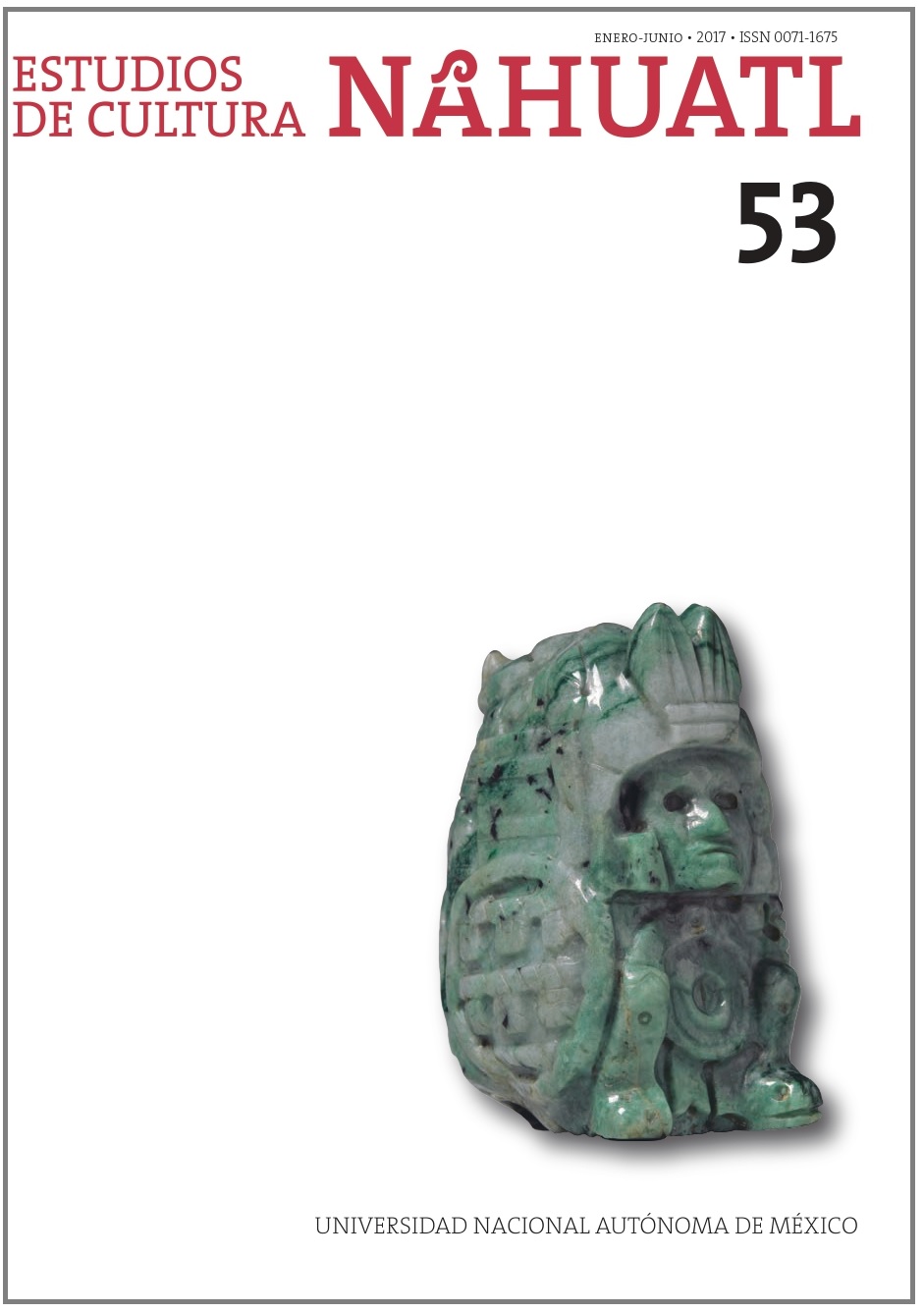Resumen
Este ensayo investiga el impacto del Encuentro de América, en particular de las misiones franciscanas, en la producción cultural de la Nueva España. Se concentra especialmente en investigar el rol que jugaron los mosaicos plumarios mexica-cristianos en la conversión de indígenas, a la vez que transmitían la invenzione artística de los mexicas a coleccionistas europeos. El ensayo pretende estudiar la re-contextualización de los mosaicos plumarios después de que cruzaron el Atlántico, es decir, la transformación de estos objetos rituales en objetos estéticos y explora la relación entre el arte mestizo y la conversión religiosa.
Citas
- Acosta, José de, Natural and Moral History of the Indies, edited by Jane E. Mangan, translated by Frances López-Morillas, Durham, Duke University Press, 2002.
- Alberti, Leon Battista, On Painting, edited and translated by Rocco Sinisgalli, Cambridge, Cambridge University Press, 2011.
- Bargellini, Clara, “The Colors of the Virgin of Guadalupe”, in Colors between Two Worlds: the Florentine Codex of Bernardino de Sahagún, edited by Gerhard Wolf and Joseph Connors, Florence, Kunsthistorisches Institut in Florenz, MaxPlanck-Institut-Villa I Tatti, The Harvard University Center for Italian Renaissance Studies, 2011, p. 3-25.
- Baxandall, Michael, Painting and Experience in Fifteenth-Century Italy: A Primer in the Social History of Pictorial Style, Oxford, Clarendon Press, 1972.
- Berdan, Frances F., “Economic Dimension of Precious Metals, Stones, and Feathers: the Aztec State Society”, Estudios de Cultura Náhuatl, vol. 22, 1992, p. 291-323.
- Butzer, Karl W., “From Columbus to Acosta: Science, Geography, and the New World”, Annals of the Association of American Geographers, vol. 82, num. 3 (The Americas before and after 1492: Current Geographical Research), September 1992, p. 543-565.
- Carreno, Alberto María, “Don Fray Alonso de Montúfar, Second Archbishop of Mexico, and the Devotion to Our Lady of Guadalupe”, The Americas, vol. 2, num. 3, January 1946, p. 280-295.
- Casas, Bartolomé de las, Apologética historia sumaria, vol. 1, Mexico City, Universidad Nacional Autónoma de México, 1967.
- Castelló Yturbide, Teresa, “Featherwork in the Indigenous Tradition”, in The Art of Featherwork in Mexico, edited by Teresa Castelló Yturbide, Mexico City, Fomento Cultural Banamex, A. C., 1993, p. 143-217.
- Colón, Cristóbal, Viajes de Cristóbal Colón, con una carta, edited by Bartolomé de las Casas and Martín Fernández de Navarrete, Madrid, Calpe, 1922.
- Cornejo Polar, Antonio, Writing in the Air: Heterogeneity and the Persistence of Oral Tradition in Andean Literatures, translated by Lynda J. Jentsch, Durham, Duke University Press, 2013.
- Cue, Alberto, “Featherwork among the Mexica”, in The Art of Featherwork in Mexico, edited by Teresa Castelló Yturbide, Mexico City, Fomento Cultural Banamex, A. C., 1993, p. 45-75.
- Cummins, Thomas, “From Lies to Truth: Colonial Ekphrasis and the Act of Crosscultural Translation”, in Reframing the Renaissance: Visual Culture in Europe and Latin America 1450-1650, edited by Claire Farago, New Haven, Yale University Press, 1995, p. 152-174.
- Davidson, Arnold I., “Miracles of Bodily Transformation, or How St. Francis Received the Stigmata”, Critical Inquity, vol. 35, num. 3, spring 2009, p. 451-480.
- Dürer, Albrecht and Philip Troutman, Sketchbook of His Journey to the Netherlands, 1520-21, New York, Praeger, 1971.
- Findlen, Paula, “The Museum: Its Classical Etymology and Renaissance Ge nealogy”, in Grasping the World: The Idea of the Museum, edited by Donald Preziosi and Claire Farago, Aldershot, Hants, Engliand, Burlington, VT, Ashgate Pub., 2004, p. 159-191.
- Francis, Henry S., “Mass of St. Gregory by Hans Baldung Grien”, The Bulletin of the Cleveland Museum of Art, vol. 39, num. 7, pt. 1, September 1952, p. 184-187.
- Giusti, Annamaria, Pietre Dure and the Art of Florentine Inlay, translated by Fabio Barry, London, Thames & Hudson, 2006.
- Guevara, Felipe de, Comentarios de la pintura, edited by Rafael Benet, Barcelona, Selecciones Bibliófilas, 1948.
- Gruzinski, Serge, “Images and Cultural Mestizaje in Colonial Mexico”, Poetics Today, vol. 16, num. 1 (Loci of Enunciation and Imaginary Constructions: The Case of (Latin) America, II), spring 1995, p. 53-77.
- ______, The Conquest of Mexico: The Incorporation of Indian Societies into the Western World, 16th-18th Centuries, translated by Eileen Corrigan, Cambridge, Polity Press, 1993.
- ______, The Mestizo Mind: The Intellectual Dynamics of Colonization and Globalization, translated by Deke Dusinberre, New York and London, Routeledge-Taylor & Francis Group, 2002.
- ______, Visions indiennes, visions baroques: les métissages de l’inconscient, Paris, Presses Universitaires de France, 1992.
- Harrington, Patricia, “Mother of Death, Mother of Rebirth: The Mexican Virgin of Guadalupe”, Journal of the American Academy of Religion, vol. 56, num. 1, spring 1988, p. 25-50.
- Heikamp, Detlef, Mexico and the Medici, Florence, Edam, 1972.
- Jones, Roger, “Mantegna and Materials”, I Tatti Studies in the Italian Renaissance, vol. 2, 1987, p. 71-90.
- Klor de Alva, J. Jorge, “Sahagún and the Birth of Modern Ethnography: Representing, Confessing, and Inscribing the Native Other”, in The Work of Bernardino de Sahagún: Pioneer Ethnographer of Sixteenth-Century Aztec Mexico, edited by J. J. Klor de Alva, H. B. Nicholson and E. Quiñones Keber, New York and Austin, the University at Albany, State University of New York (Institute for Mesoamerican Studies)-University of Texas, 1988, p. 31-52.
- López de Gómara, Francisco, Historia de la conquista de México, edited by Jorge Gurría Lacroix, Caracas, Fundación Biblioteca Ayacucho, 2007.
- MacDonald, Deanna, “Collecting a New World: The Ethnographic Collection of Margaret of Austria”, The Sixteenth Century Journal, vol. 33, num. 3, autumn, 2002, p. 649-663.
- Markey, Lia, “The New World in Renaissance Italy: A Vicarious Conquest of Art and Nature at the Medici Court”, Ph.D. dissertation, Faculty of the Division of Humanities, Department of Art History, University of Chicago, 2008.
- María y Campos, Teresa de, “Rich Feathers, Fine Feathers”, in The Art of Featherwork in Mexico, edited by Teresa Castelló Yturbide, Mexico City, Fomento Cultural Banamex, A. C., 1993, p. 27-41.
- Martínez del Río de Redo, Marita, “Featherwork during the Viceroyalty”, in The Art of Featherwork in Mexico, edited by Teresa Castelló Yturbide, Mexico City, Fomento Cultural Banamex, A. C., 1993, p. 103-139.
- Mendieta, Gerónimo de, Historia eclesiástica indiana, vol. 3, Mexico City, Editorial S. Chávez Hayhoe, 1945.
- Molina, Alonso, Vocabulario de la lengua castellana y mexicana, Mexico City, Antonio de Spinosa, 1571.
- Rivero Weber, Lilia and Christian Feest, “Der Schatten der Götter. Mexikanische Federarbeiten des 16. Jahrhunderts”, in Der Altmexikanische Federkopfschmuck, edited by Sabine Haag, Alfonso De María y Campos, Lilia Rivero Weber and Christian Feest, Altenstadt y Mexico City, ZKF Publishers-Consejo Nacional para la Cultura y las Artes, 2012, p. 41-60.
- Russo, Alessandra, “De Tlacuilolli: Renaissance Artistic Theory in the Wake of the Global Turn”, in Art History in the Wake of the Global Turn, edited by Jill H. Casid and Aruna D’Souza, New Haven, Yale University Press, 2014, p. 20-39.
- ______, Gerhard Wolf and Diana Fane, El vuelo de las imágenes. Arte plumario en México y Europa, Mexico City, Museo Nacional de Arte, 2011.
- ______, “Plumes of Sacrifice: Transformations in Sixteenth-Century Feather Art”, Res: Anthropology and Aesthetics, vol. 42, 2002, p. 226-250.
- ______, “Uncatchable Colors”, in Colors between Two Worlds: the Florentine Codex of Bernardino de Sahagún, edited by Gerhard Wolf and Joseph Connors, Florence, Kunsthistorisches Institut in Florenz, Max-PlanckInstitut-Villa I Tatti, The Harvard University Center for Italian Renaissance Studies, 2011, p. 389-410.
- Sahagún, Bernardino de, Historia general de las cosas de Nueva España, digital version of codex 218, Biblioteca Medicea Laurenziana, Florence.
- Saunders, Nicholas J., “Stealers of Light, Traders in Brilliance: Amerindian Metaphysics in the Mirror of Conquest”, RES: Anthropology and Aesthetics, vol. 33 (Pre-Columbian States of Being), spring 1998, p. 225-252.
- Vasari, Giorgio, The Lives of the Most Excellent Painters, Sculptors, and Architects, edited by P. Jacks, translated by G. du C. de Vere, New York, The Modern Library, 2006.
- Velázquez, Primo Feliciano, trans., “Anales de Cuauhtitlan”, in Códice Chimalpopoca, Mexico City, Universidad Nacional Autónoma de México, 1945, p. 3-68.
Cómo citar
Licencia
Derechos de autor 2017 Universidad Nacional Autónoma de México

Esta obra está bajo una licencia internacional Creative Commons Atribución-NoComercial-SinDerivadas 4.0.
- Resumen visto - 326 veces
- PDF (English) descargado - 270 veces


 Estudios de Cultura Náhuatl se encuentra bajo una
Estudios de Cultura Náhuatl se encuentra bajo una 








